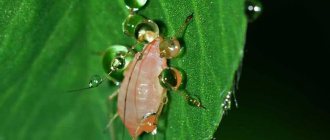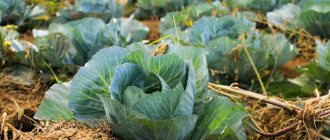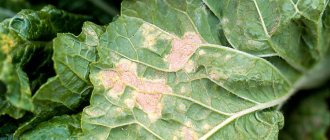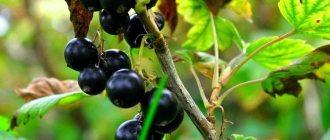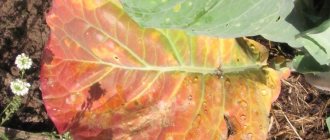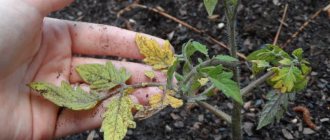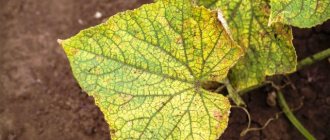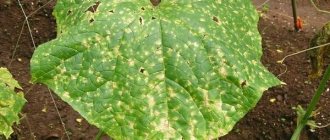Improper watering
Signs
Cabbage seedlings react to excess or lack of moisture by changing their leaf blades.
- Excessive watering causes root rot, which leads to a decrease in leaf turgor with subsequent yellowing.
- Poor watering means a lack of nutrients from the soil, the growth of seedlings is stopped, they turn yellow and dry out.
Prevention
- Water only when the top layer of soil dries.
- Loosening after each watering.
Treatment
If yellowing of the leaves of cabbage seedlings occurs due to stagnation of moisture, then stop watering the seedlings until the soil dries 5 cm.
Important: if the top layer of soil has formed a dense crust, check the condition of the root system. At the first sign of blackleg, remove the affected plants and pick.
If the leaves of cabbage seedlings turn yellow due to lack of moisture, then adjust the watering regime. Take only settled water at +22…+24°C.
What pests provoke the death of cabbage
Often the cabbage dies even before the head of cabbage forms, the leaves begin to wither and curl, and then the cabbage dies altogether. The reason for this problem may be the activity of pests. Many parasites feed on sap or infect the root system of the plant, causing negative consequences.
Cruciferous flea beetle
With the arrival of the first warm days, cabbage may be affected by flea beetles. This is a small insect that eats round holes in the leaves and feeds on the sap of the plant. The leaves gradually dry out, and over time the cabbage also dies. To protect the plant, the following chemicals are used: Sumicidin, Tolkodorm.
Cabbage fly
This is a small gray pest, up to half a centimeter in size. It spends the cold in the soil (for this reason, you should do a deep digging of the site in the fall). As the weather warms, the parasite begins its mass migration and lays eggs at the roots of the cabbage. The larvae eat holes in the leaves and make tunnels. The best means of control is burdock infusion: 2.5 kg of leaves are poured with a bucket of water and left for a couple of days, and then the cabbage beds are treated. Among chemical preparations, Ambush is often used.
Aphids and whiteflies
Cabbage aphids and whiteflies are small harmful insects that can cause a lot of damage. Aphids suck moisture and nutrients from the leaves, causing the plant to become lethargic and dry out. To eliminate the parasite, use a decoction of wormwood or tansy, as well as a garlic infusion with the addition of hot pepper. Glue traps, garlic tinctures, bleach solution and dandelion infusion help against whiteflies. The drugs Iskra, Fufafon, Corsair and Cyanox also help.
Centipede
In appearance, the centipede resembles a mosquito. The parasite lives near the roots of cabbage, eating and sucking out nutrients. As a result, the plant withers and dries out. Control measures: timely elimination of weeds and removal of plant residues from the beds, deep digging of the soil and compliance with crop rotation rules. When a parasite is detected, calcium cyanamide irrigation is used.
Cabbage leaf beetle
At the beginning of June, the cabbage leaf beetle pest appears - a small shiny dark green bug with gray legs. The female parasite gnaws small holes in the plant and lays eggs. The pest larvae begin to feed on cabbage juice, causing the leaves to wither and dry out. Insecticides are used to control the leaf beetle. For example, Actellik (20 ml of product per bucket of water will be enough). Among the traditional methods, spraying with tobacco powder and ash will be effective.
Lack of lighting
Signs
In low light, the seedlings stretch upward, the lower leaves become smaller and turn yellow. The first sign is a change in the color of the stem part. Often cabbage seedlings turn yellow on the windowsill if the windows face north.
Prevention
Daylight hours for cabbage seedlings should last at least 14 hours, with direct sunlight falling on the seedlings for 6 hours.
Considering that the seeds germinate already on the 3-4th day, from the moment of sowing the boxes with seedlings are placed on sunny (southern) windows. If this is not possible, be sure to add additional lighting.
Attention: foil can be used to enhance the lighting.
Treatment
At the first signs, it is necessary to remove yellowed leaves and adjust the light regime. Remember that an excess of lighting also negatively affects the condition of the seedlings, as does a lack.
Incorrect temperature
Signs
The optimal temperature regime for cabbage seedlings is +8...+12°C. Under more comfortable conditions, the seedlings stretch upward, their development slows down, and the root system cannot grow stronger. The result is yellowing of the leaves and stem parts.
Prevention
After sowing and until germination, the boxes are kept under film or glass at a temperature of +18...+20°C. As soon as the sprouts hatch, the temperature is lowered to +7...+10°C. The maximum that cabbage seedlings can withstand is +12…+14 degrees. If these measures are not followed, the seedlings will begin to stretch upward, weaken and turn yellow.
Treatment
There is no specific treatment. It is necessary to provide the seedlings with comfortable conditions: at low temperatures, the seedlings will stop growing, and the plant will devote all its energy to the formation of the root system.
Poor nutrition
Signs
Cabbage seedlings do not need additional feeding before planting the seedlings in a permanent place. However, if the soil composition for young plants was incorrectly selected or the seeds were sown in ordinary garden soil, the seedlings may experience starvation. Lack of potassium and nitrogen leads to yellowing of leaf tips.
Prevention
To prevent mineral starvation, during the seedling period it is necessary to feed the seedlings three times:
- after the formation of the first two true leaves;
- a week after the pick;
- before hardening.
Seedlings are fertilized by spraying with complex fertilizers.
Treatment
Either extraordinary fertilizing or partial replacement of the soil with soil pre-mixed with organic and mineral fertilizers will help stop the yellowing of leaves.
To do this, water the soil with a solution of ammonium nitrate at the rate of 4 g of product per 1 liter of water. They replace the top layer of soil in the box at the first sign of a lack of elements. Fertilized soil can completely replace soil when picking.
What should a summer resident do and is it possible to save diseased cabbage?
There is no point in treating if clubroot has affected seedlings or an adult plant. The disease is caused by a harmful fungus that persists in the soil for six years. The first thing a summer resident should do is remove and burn all diseased plants.
Factors causing the disease:
- acidic soil;
- high soil moisture;
- soil heated to 20-25 °
Growing cabbage on a ridge where clubroot has been detected cannot be done for 5-6 years. In autumn, the soil must be cleared of all plant debris and disinfected. Use bleach for disinfection. The critical concentration for fungus is 200 g per square meter. m.
Spider mite
Signs
Black inclusions and small cobwebs appear on the reverse side of the sheet, and the surface of the plate becomes sticky. Moreover, even a detailed examination of seedlings with the naked eye does not make it possible to see the pest.
A few days after the first signs, the leaves turn yellow and dry, which ultimately leads to the death of the entire plant.
Prevention
The first measure to prevent spider mites is thorough treatment of seedling containers and disinfection of seed material. During cultivation, it is necessary to observe the temperature conditions for this crop. The higher the thermometer, the more favorable the conditions for insect life become.
Treatment
If a spider mite is found on cabbage seedlings, the leaves are washed with running water and sprinkled with wood ash or tobacco dust. Yellowed leaves must be removed.
After planting in the ground, the seedlings are also treated with fly ash or watered with a weak solution of ammonia.
Water and spray
Countryside magazines are full of advertisements for modern means for caring for seedlings: these include nutritional complexes and growth stimulants. Should you believe the advertising? I don’t know what about the other remedies, but Epin-Extra was tested by us personally and gave a positive result. True, we are not talking about seedlings at all, but about a houseplant. We purchased a young anthurium shoot, planted it in fresh soil, and watered it moderately. But the flower took root very poorly: it looked sad, the edges of the leaves dried out, and did not grow for a long time. According to the instructions, 2 drops of Epin were dissolved in 1 glass of water (250 ml) and sprayed on the anthurium, and at the same time all other indoor plants. After a couple of days it looked much more cheerful, and after a week it sprouted new growth. The growth stimulator worked! The instructions say that Epin is also used for seedlings after picking and in stressful situations.
Among the means that revive fading plants are:
- Zircon,
- Ferovit,
- NV-101,
- Kornevin,
- Energen,
- Athlete.
Aphid
Signs
Aphids can easily be found on the leaves of cabbage seedlings. Colonies settle on the underside of the leaf blade. Due to the weakness of the seedlings, the leaves first turn yellow, and then become transparent and dry.
Prevention
The main preventive measure against aphids is the treatment of boxes and soil before sowing seeds. To do this, use a solution of manganese. Chemicals are useless at this stage.
Treatment
Having discovered the first signs of aphid damage to cabbage seedlings, you should immediately take action. Use insecticides or folk remedies.
Insecticides:
- Aktara;
- Iskra-M.
Folk remedies:
- tobacco solution;
- ammonia solution;
- wood ash;
- tar soap;
- solution of soda and soap;
- mustard powder.
Fusarium
Signs
If the temperature regime is violated, cabbage seedlings become subject to attack by the fungus Fusarium oxysporum Schl. f. conglutinans Bilai, which causes Fusarium leaf wilt. Signs of the disease are loss of turgor in leaf blades, the appearance of chlorotic veins with gradual yellowing of the entire leaf, complete drying of the blades with their subsequent death.
One of the signs of fusarium is the spread of the disease from bottom to top.
Prevention
One of the protective measures is the treatment of seed and soil with Fitosporin-M. It is not recommended to use uncultivated soil from the garden for seedlings. To prevent the spread of the disease, maintain the soil temperature at +15 degrees, maintain the watering regime and thin out the seedlings in a timely manner.
Treatment
When diagnosing Fusarium wilt of cabbage seedlings, the soil is watered with a solution of copper sulfate at the rate of 5 g per 10 liters of water. The leaves are sprayed with Agat-25 or Immunocytophyte.
Chemical methods to combat wilting of cabbage leaves
To prevent cabbage from being affected by pathogens and insect pests during the growing season, preventive treatments with fungicides and insecticides should be carried out from the very beginning of growing seedlings. And also timely introduce the necessary minerals and trace elements into the soil. If an infection or pest attack begins to develop, it is necessary to immediately begin the fight to neutralize them.
Spraying against fusarium wilt
If cabbage is seriously damaged by fusarium spores, the plant should be immediately dug up and burned. However, if the disease is just beginning to develop, the following drugs have proven themselves well: Posaconozole, Trichopolum, Agat-25, Vitaros, Topsin-M, Baktofit, Maxim, Previkur.
Treatment against downy mildew and black rot
Not only spraying with chemicals will help save cabbage from these diseases, but also following the correct agricultural practices such as crop rotation, timely fertilizing and loosening the soil. The following fungicides will cope well with black rot and downy mildew: Acrobat-M, Quadris, Topaz, Fitosporin, Gamavir.
Important! When treating cabbage against fungal pathogens or viral diseases, chemical preparations should be alternated. This is necessary so that the parasites do not have time to develop immunity to the fungicide.
Treatments against clubroot
Clubroot tumor spores are so tenacious that they remain viable in the soil for 9-10 years. Therefore, you should not only destroy diseased plants, but also carry out sanitary treatment of the soil: not slaked lime, Bordeaux mixture, bleach or Acrobat.
Spraying against parasitic insects
When attacked by parasitic insects that cause damage to cabbage leaves, preventive treatments are carried out with insecticides: Lightning, Decis, Senpai, Aktara, Belt, Bazudin, Iskra, Aktellik, Vertimek.
Blackleg
Signs
The first sign of blackleg is thinning of the stem in the root zone with its simultaneous blackening. At the same time, the lower leaves become thinner, turn yellow and become covered with dark spots.
Reasons for the development of blackleg:
- use of contaminated seed;
- waterlogging of the soil;
- temperature difference;
- increased soil pH level;
- dense planting.
Prevention
Preventive measures are aimed at both working with seed and soil.
- Treatment of seeds with Fitosporin at the rate of 2 drops per 200 ml of water or Baktofit.
- Calcination of the soil in the oven at a temperature of 100 degrees for 30 minutes.
- Adding wood ash to the soil to lower the pH level.
- Treating the soil with a solution of manganese or copper sulfate.
Treatment
If a black leg is found on cabbage seedlings, the affected bushes are removed, healthy ones are transplanted into new containers with mandatory watering with a manganese solution. Seedlings are sprayed with Fitosporin-M and the leaves are treated with Pervikur Energy.
Why cabbage leaves turn yellow - the main reasons
Why cabbage leaves have turned yellow worries many gardeners during the period of its intensive growth. Let's talk further about how to prevent this phenomenon and save the harvest.
There is rarely a person who does not like cabbage. Without this product, cooking will be greatly impoverished.
And whoever grew seedlings and carefully cared for the sprouts, reverently expecting beautiful heads of cabbage to appear on the plot in a few months, knows and appreciates cabbage more than anyone else.
When the lower leaves of the head of cabbage take on a yellowish color before harvesting, this is a natural process indicating full ripening.
And when the leaves suddenly begin to turn yellow and become flabby during the growing season, this is not a normal process.
We urgently need to understand the reasons and eliminate them.
Sometimes this is very quick and simple, but you may have to make some efforts so that all the work invested along with the harvest does not go to waste.
Acceptable states of yellowing of seedlings
- Cabbage seedlings do not always turn yellow due to disease or pest damage. The cause may be stress due to a sudden change in external conditions.
- It is not recommended to move cabbage seedlings from place to place; the temperature, air humidity and lighting should be constant.
- After transplanting into the ground, the plants should be shaded, since fragile seedlings may react to too much sun by changing the color of the leaves.
- The lower leaves also turn yellow when picked. This is how plants react to root damage. In this case, the affected leaves are torn off and the seedlings are watered abundantly.
Why do seedlings wither and dry out after transplanting into the ground?
Often strong green seedlings wither after being planted in the ground. They determine why the plants have changed and decide what to do in a particular case.
- If wilting is caused by a change of location, after 5–7 days the culture will regain its strength. To facilitate survival, the seedlings are covered with non-woven material (paper) after transplanting to the garden bed.
- If the roots are damaged during transplantation, the seedlings are watered abundantly, thoroughly loosened and hilled to stimulate the formation of new roots.
- Sometimes the acidity of the soil in the area is higher than the acidity of the soil in which the seedlings were grown. 15 days before planting, 1 table is placed in the planting holes. l. dolomite flour, mix thoroughly.
The area for growing the crop is prepared in the second half of autumn. Once every 5–7 years, 0.3 kg of lime is added for every 1 m2 of soil.
Reference! After picking, seedlings may wither and stop growing if the roots are poorly compressed. To prevent the appearance of air voids, the soil around the seedlings is compacted.
